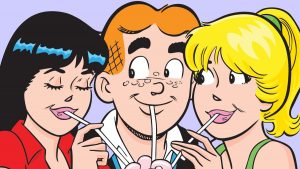
In space no one can hear you scream. Or at least that is what some rather ingenious 20th Century Fox marketers pushed back in 1979. Yet we did hear the people scream, and gasp, and panic as the facehugger’s tendrils tightened around John Hurt’s throat in movie houses across the world. And in the near half-century that followed, those screams continue to echo in our ears.
Hence this weekend’s anticipated return of the xenomorph in Alien: Romulus, a movie which star Cailee Spaeny previously described to us as walking a careful line between the understated dread of the ’79 classic and the “‘80s drama” that defines James Cameron’s Aliens. That’s quite a tightrope, too, because more than any other modern movie franchise, each entry of the Alien series has been unique and singular in its approach. With the exception of some unfortunate crossover flicks (more on them in a moment), there is no Alien movie to date that hasn’t been a labor of love—or at least passionate madness. Obviously some yielded better results than others, however almost every one is worth multiple revisits.
Below is thus our humble estimation of how to rank the nine Alien films released to date.
9. Alien vs. Predator: Requiem (2007)
In 2004 it became a common refrain among fans that the reason Paul W.S. Anderson’s Alien vs. Predator spectacle felt so inherently hollow is because that movie was rated PG-13. While we admit that making a film set in the worlds of either Alien or Predator, and then deliberately foregoing the gore and tension that often warrants an R-rating, was tying that film’s hands behind its back, leave it to Alien vs. Predator: Requiem to remind you that gratuitous violence does not a good movie make.
Of course it would’ve helped if fans could see that gratuitous gore and violence. Alas, the quickie, rushed, and underfunded Alien vs. Predator: Requiem appears as if it was shot on a moonless night in the suburban backwoods with only a couple of flashlights passing as the lighting department. Cast mostly with talent comparable to Asylum’s straight-to-video racket, this sequel squanders AvP’s promised stinger of an Alien-Predator hybrid, just as it throws away the nightmare that kept Sigourney Weaver’s Ripley awake during all those sequels: What if these creatures made it to Earth?! As it turns out, the worst thing that could happen is a dull, incoherent eye sore. – David Crow
8. Alien vs. Predator (2004)
We will admit there was some internal debate about whether to include the Alien vs. Predator flicks. Produced during 20th Century Fox’s worst years for genre entertainment under Tom Rothman’s leadership, these were soulless, condescending contraptions that did a disservice to both franchises while pleasing no one. James Cameron lacerated them, Ridley Scott refused to acknowledge them when he returned to the Alien series proper in 2012, and even fans who loved AvP comic books and video games recognized they were time-wasting schlock.
Truthfully, we’re not sure if the concept could ever truly work. Tonally and aesthetically Alien will always feel closer to the cynical nihilism of Blade Runner than John McTiernan’s charming “guns and guns” sci-fi actioner. Still, writer-director Paul W.S. Anderson does a few fun things with his first stab at AvP. The creature designs are solid, the sight of an Alien Queen impaling the neon-green viscera out of a Predator is Hall H-worthy, and the inevitable third-act team-up between a Predator and human fulfills the plot obligations of nearly every AvP video game. These are, however, strained surface-level compliments for a movie that did more harm to the xenomorph and Predator than Sigourney Weaver or Arnold Schwarzenegger could ever dream. – DC
7. Alien: Covenant (2017)
There are some things to admire about Alien: Covenant, so placing it at the bottom of the true Alien franchise is sure to ruffle feathers. Yet for all the staggering ambition in Ridley Scott’s third trip into this despairing universe he helped create, Alien: Covenant suffers from a cardinal sin: it threw away the even more astounding ambition of its predecessor, Prometheus.
Whereas that film boldly ignored the “xenomorph” from Alien in favor of H.R. Giger’s elephantine “space jockey”—and in the process asked larger questions about the nature of man and the origin of life—Alien: Covenant feels like a half-hearted retreat and concession to audience expectations… or at least how those were perceived by the studio. Scott and the film betray a sense of resignation as the picture returns to the same beats of an alien stalking crew members of a spaceship. In the process of getting there, the film abandons Noomi Rapace’s Dr. Elizabeth Shaw from Prometheus in the cruelest way imaginable, and perhaps more dispiritingly disposes of the space jockey, or “engineers,” a species that offered a myriad of possibilities for this saga’s future.
Nonetheless, Alien: Covenant still is a gorgeous film with Scott and his collaborators intentionally evoking a baroque Gothic aesthetic on an alien planet wherein the film’s dead meat find themselves. The director also wrestles with his own notions of both creation and mortality in the form of this franchise’s best character outside of Ellen Ripley: a synthetic android named David (Michael Fassbender). With his own maker gone, Fassbender’s David is posited as Lucifer unbound, a fallen angel freed to play god. Never before has playing a flute been so seductive. This Milton-infused conception reduces the original films’ “perfect organism” into a literal demon born from a paradise lost. It’s all so brazenly ludicrous to be almost tempting. – DC
6. Alien Resurrection (1997)
In almost every respect, Alien Resurrection is the safest and most studio-friendly iteration of the original Alien “quadrilogy.” After all, it doesn’t get much more ‘90s than bringing back a character you killed off in the last movie by way of a Jurassic Park-like cloning plot—and then have her play some badass space basketball on a set that looks straight out of a Michael Jordan Nike commercial. And yet, for all its crass commercialism, there is a whimsical and even artful soul to this oddity, thanks largely to the bizarre choice of getting French filmmaker Jean-Pierre Jeunet to helm the long-in-the-tooth sequel.
Years before writing and directing the delightful Amélie, Jeunet took the most cynical studio gig this side of a Jaws add-on and turned it into a strange, nigh beatific metaphor for the loss and reinvention of one’s self-identity. As a clone of Ellen Ripley, risen several centuries after the original’s death, Weaver embraces a degree of camp in her xenomorph-hybrid character, but also sincere humanist grounding. The pitying love she conveys for the monstrous “Newborn” half-human, half-alien baby she put out into the cosmos gives the movie a sense of operatic mad science grandeur. And the Newborn’s subsequent demise would’ve done James Whale proud.
The rest of the film has the novelty of being a superbly directed satire of ‘90s movies clichés, including that aforementioned basketball scene where Weaver really sank that over the shoulder three-pointer; there’s also the ensemble of ciphers underwritten by a Joss Whedon screenplay which, in retrospect, acted as a dry-run for Firefly; there’s even a queer-baiting lesbian romantic subplot between Ripley and Winona Ryder’s self-loathing android. With gorgeous cinematography by Bruno Delbonnel and a few crackerjack action sequences that border on a parody of the series—including Leland Orser using his fatal chestburster as a weapon in his last moments of life—Alien Resurrection is a campy good time. It’s also a couple million lightyears from where the series started. – DC
5. Alien 3 (1991)
Swiftly put into production after the success of Aliens but taking almost six years to reach the screen, Alien 3 was a nightmare from start to finish. Beginning as a collection of ideas rather than a clear story, and perhaps even ending that way if you ask its most vocal detractors, the movie went through a revolving door of directors and writers before a 27-year-old David Fincher stepped in for his debut. Had Fincher known what was coming next, it’s likely he would have remained in TV commercials and music videos for a few more years. But despite all the behind-the-scenes problems, which are well-documented, he managed to pull something genuinely interesting from the quagmire of interfering studio bosses, script rewrites, and reshoots.
Alien 3 sees Ripley land on the barren planet Fiorina ‘Fury’ 161, which happens to double as an all-male prison planet. Waking from her hypersleep to learn that the shred of comfort she gained at the end of Aliens—a potential lover in Hicks, a surrogate daughter in Newt—were killed in the crash, Ripley realizes that an alien has landed with her. Worse still, she begins to suspect that she herself may have been impregnated by an alien during cryosleep.
A gothic sense of impending doom hangs like a fog in Alien 3. It’s a movie seemingly obsessed with mortality and the fleshy vulnerability of all living things. Whether it’s the new alien, emerging in a slick of blood and amniotic fluid from its host, or the full-grown monster breathing its foul breath over Ripley’s shaven head, Fincher’s camera captures every nuance of the planet’s deathly texture. That texture extends to the performances. Sigourney Weaver, who at this point was intent on quitting the franchise, turns in what I’d suggest is her finest performance as Ripley. It’s a turn full of sorrow and loneliness, but also determination: the alien is an inescapable demon from her past, and she fights it right to the bitter end. Weaver’s joined by a great supporting cast, including Charles Dance as disgraced physician Clemens (who deserved a much larger role), Charles S. Dutton as Dillon, the inmates’ moral compass, and Brian Glover as incredulous prison warden Andrews.
Admittedly, Alien 3‘s production difficulties are apparent at times—even in the far superior Assembly Cut released in 2003. The proportions of the alien vary from one shot to the next, and the final third descends into a muddy and bewildering chase through narrow corridors. But Alien 3 also gets back to the haunted-house-in-space moodiness of Alien, and while it gives Newt and Hicks cruelly short shift (an idea taken from director Vincent Ward’s earlier story concept), it treats Ripley and her nemesis with dignity and intelligence. Plus: Elliot Goldenthal’s score is a thing of bone-chilling beauty. – Ryan Lambie
4. Alien: Romulus
Placing an installment as new as Alien: Romulus on a list like this is a tricky thing. The film has barely been out a day, and after only one viewing, our perception of it is more of a snapshot than a sober understanding of an opinion that’s had years or decades to crystalize. So there is admittedly some hesitation about placing a film as besotted with “playing the hits” as Romulus over entries that actually made a few of those hits, chiefly Resurrection and Alien 3.
Be that as it may, based purely as an exercise in entertainment, Alien: Romulus was a lot more satisfying on first viewing than the downsides of Alien 3’s nihilism and Resurrection’s goofiness. In fact, for the first time in the franchise’s history, a new entry has been made by a fan who grew up with the original quadrilogy. And director Fede Alvarez lovingly, painstakingly homages it all while giving pride of place to Ridley Scott’s Alien. The grimy, sweaty, roughness of the Nostromo is at last returned to us, as is the sense of overbearing dread and menace. Alien: Romulus is a slickly produced teeth-gnasher with great suspense and a few appropriately queasy visual gags befitting the director of Don’t Breathe.
With that said, Romulus brings little new to the table. Its cast of characters are predominantly ciphers who could populate any slasher movie. Star Cailee Spaeny is always interesting to watch and she gives a little blue collar texture to the latest Ripley clone, Rain, but there’s only so much on the page. David Jonsson gets more to play as her adopted brother, a somewhat slow and mistreated android named Andy. His curious evolution, and the guilt it elicits in Rain, is the movie’s one real stab at thematic teeth. Overall, though, this is an exercise in finding a way to make Alien’s scares still horrifying 45 years later. And, frankly, it mostly succeeds, with an elevator shaft sequence in zero gravity being a particular highlight.
Fairly characterized as “The Force Awakens of Alien movies”—it is produced by Disney—Alien: Romulus plays it safe, but that safety evokes some very solid fan-pleasing moments which eerily conjure up an atmosphere of interstellar doom and gloom we thought lost. It’s a throwback that makes you feel like you’re home… assuming home is the the tensest, greasiest freakshow in the cosmos. – DC
3. Prometheus (2012)
Another of this series’ audacious big swings that doesn’t fully connect, Ridley Scott’s long-awaited return to the franchise still has a lot going for it. Especially if you don’t focus too much on the screenplay. Sharply noticing that Fox spent most of the previous 30 years running the “xenomorph” design into the ground, Scott instead used his visually captivating prequel to focus on the first movie’s most intriguing mystery: what the hell was that “space jockey” tied to the wheel of an alien derelict like an extraterrestrial captain of the Demeter?
We’ll admit choosing to make the answer not an elephantine creature is somewhat disappointing. However, imagining that alien (or “engineer”) was of a species that created all life on Earth, plus the “xenomorph” as some form of biological weapon, is just a few of the many heady and intoxicating ideas Scott wrestles getting his arms around. The aforementioned screenplay by Jon Spaihts and Damon Lindelof is the film’s biggest weakness; it reduces a whole spaceship’s worth of scientists into having the kind of intelligence and survival instincts of horny teens in a Friday the 13th flick. But the larger themes and ideas Scott uses these fools to explore in gorgeous sets and cinematography is as occasionally dazzling as it is revolting.
In a sequence that is even timelier today, star Noomi Rapace’s Dr. Elizabeth Shaw gets a moment worthy of Ripley where she realizes there is an alien inside of her that the men in power wish to force her to carry. So she performs a veritable abortion with sci-fi equipment and no drugs. The feminist undertones in this body horror all-timer feel all the more pronounced today. Meanwhile the film’s other moments of quiet and stillness whenever Michael Fassbender’s Peter O’Toole-cosplaying android, David, is onscreen beg the viewer to lean forward. The mysteries created by David’s smiling, searching eyes and the engineers’ wrath will sadly never be satisfyingly answered due to Covenant’s sins, but Prometheus is the kind of grand and beautiful sci-fi we rarely get anymore, warts and all. – DC
2. Aliens (1986)
Still a relative unknown in Hollywood when he came up with his concept for Aliens, James Cameron didn’t seem fazed by the task of following Ridley Scott’s seminal space horror movie. To a modern audience accustomed to sequels and multi-film universe building, the way Cameron took the bones of Alien and scaled them up into something bigger—while at the same time remaining true to its nightmarish spirit—might be easy to overlook. But even all these years later, Aliens is still one of the greatest sequels of all time.
Rather than create a retread of what came before, Cameron treats Alien as the first half of a much larger story. Ripley, having survived her encounter with the ferocious creature that hatched out on the Nostromo, is rescued and brought out of cryosleep. Traumatized and haunted by nightmares of what she’s seen—nightmares, it’s implied, she’s been having ever since she got into her cryotube—Ripley’s offered a chance to head back to where the alien was first discovered: LV-426. During the years she spent drifting in space, a colony was set up on the windswept planet, which has since winked out of contact. Hired as a kind of advisor to a group of over-confident Colonial Marines, Ripley returns to face the toothsome menace that wiped out her crew.
Although Cameron clearly loves showing off the details of his futuristic weaponry and revels in the fast-talking patter of his characters, he never loses sight of what makes Ripley the perfect survivor: unlike just about everyone else in the Alien universe, she never underestimates the xenomorph’s power. This, I think, is what makes Aliens so engrossing, even after repeat viewings. Unlike the Marines, Ripley isn’t a warrior, but it’s thrilling to see how events turn her into one toward the film’s end.
These, of course, are only some of the aspects that make Aliens such a fantastic film. Lance Henriksen is superb as Bishop, the cagey but ultimately benign android. The script is endlessly quotable. The score is note-perfect. The action ramps perfectly to a thrilling conclusion. After Aliens, it’s little wonder that Hollywood’s screenwriters struggled to think of a way to follow it. – RL
1. Alien (1979)
Having heaped praise on Aliens, it might seem strange to rank it behind Alien. But for me, the original remains the best: prowling, disturbing, unsettling. From those opening credits where the title gradually appears to the sound of howling wind and Jerry Goldsmith’s murmuring score, Alien is a masterpiece of sustained unease. There are jabs of horror, some of them quite shocking today, but still the tension remains; every frame of the film seems haunted somehow.
The minimalism of the plot is one of Alien’s strengths. Here is a group of astronauts is woken from its sleep in an unknown system, apparently because of a distress signal emanating from a nearby planet. Stopping off to investigate, they unintentionally bring something horrible back to their ship.
Alien is one of those rare films where every casting and design decision seems perfect. Cast for the strength of their acting rather than star magnitude, Alien’s cast—which includes Ian Holm, Tom Skerritt, Yaphet Kotto, and John Hurt as well as Sigourney Weaver—provide muted, mundane realism. Their characters don’t philosophize about the enormity of the universe or their place in it; they grumble about bonuses and the state of the ship’s food.
That grounded realism plays off against the otherworldly imagery conjured up by artist and designer H.R. Giger. When the crew of the Nostromo stumble on the derelict alien craft, there’s the real sense of two worlds meeting for the first time. The artifacts they find inside all hint tantalizingly at a much bigger mystery (one that would be expanded on in Prometheus), and also point to their own imminent doom.
Alien’s most famous set-pieces barely need describing in detail yet again: the discovery of the Space Jockey, the opening of the egg, the birth of Kane’s son. Those sequences are so powerful that it’s easy to fix on them while at the exclusion of other incredible moments, such as the early tracking shot through the Nostromo, as its crew awakens; Brett’s ill-fated search for Jones the cat, brilliantly cut together by editor Terry Rawlings; every scene between Ripley and Ian Holm’s Ash, whose passive-aggression eventually gives way to violence with an alarmingly perverse edge.
Watching Alien yet again after more than 35 years, and particularly in light of the sequels which followed it, Scott’s film still functions perfectly as a work of space horror. Its attention to detail is flawless, its story uncluttered, its horror unrelenting. Where subsequent films were forced to elucidate as they expanded the Alien universe, Alien remains enshrouded in mystery—and in its mystery lies its power.
As Ash glibly admits toward the film’s end, “I admire its purity…” – RL
The post Alien Movies Ranked (Including Romulus!) appeared first on Den of Geek.









